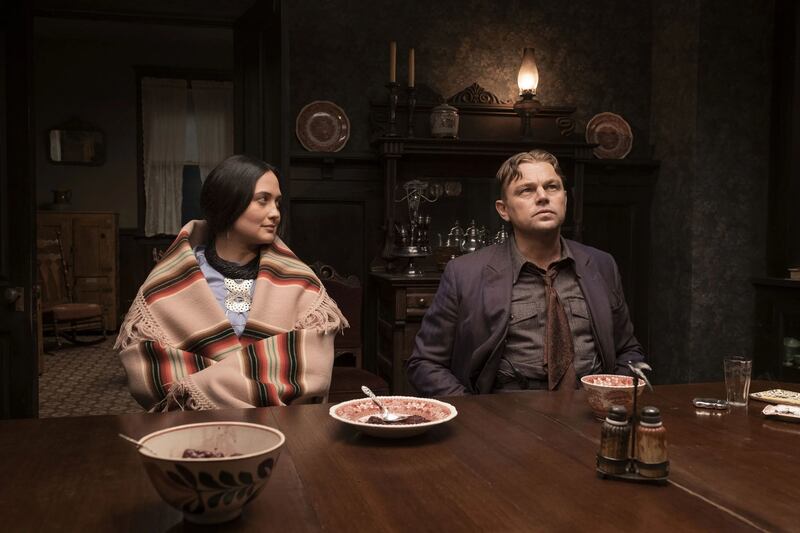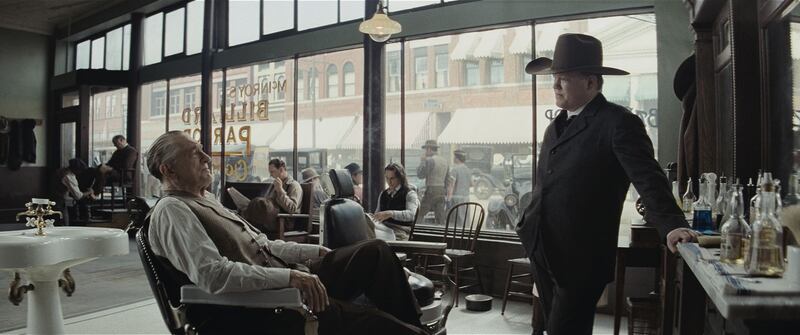The sprawling new epic from Martin Scorsese, premiering here at Cannes after an insanely starry red carpet, begins with something like a misdirection. A number of the Osage people are performing a ceremony in their native Oklahoma when, close to spontaneously, a gusher bursts up and drenches them in liquid prosperity. Robbie Robertson’s score kicks in with a bluesy riff as the oil continues to flow. It’s a zesty moment that suggests we may be playing to the rhythms of Scorsese joints such as Goodfellas.
There certainly are reminders of that 1990 film in Killers of the Flower Moon. Once again, a senior mentor (Robert De Niro in both cases) lures a younger dupe (Leonardo DiCaprio here) into an escalating campaign of violence that seems likely to consume all in its wake. This is, however, an altogether more deliberate work – sometimes too darn deliberate – that works fewer variations into its catalogue of atrocities. It is considerably less at home to humour. It allows its malign protagonists less appalling charm. Clocking in at close to 3½ hours, Killers of the Flower Moon rates high in the 21st-century Scorsese canon, but it asks its viewers for substantial patience.
Based on a much-admired book by David Grann, the film casts DiCaprio – jaw swollen angrily throughout – as Ernest Burkhart, a young man returning from the first World War to a hometown dependent on the now insanely wealthy Osage people. The screenplay, by Eric Roth and the director, deftly allows us to deduce that the white population is involved in an ad-hoc conspiracy to filter away the Native Americans’ wealth. More rapidly than the book, Scorsese’s film confirms that William “King” Hale (De Niro), a local bigwig and uncle to Burkhart, is prepared to go further than mere legal circumlocutions. The natives are taking leave of this earth in a bewildering array of suspicious manners. They are shot, stabbed and blown up. Too many are dying from a “wasting disease”.
[ Killers of the Flower Moon: The calamity of the Osage oilOpens in new window ]
Shortly after his arrival, Burkhart seems to fall simultaneously for an Osage woman, Mollie (Lily Gladstone) and for her people’s petromillions. As his involvement with Hale’s schemes increases, their relationship is teased out in unusual fashion. He does seem to love her. But we suspect he wouldn’t be entirely opposed to the notion of bumping her off. Such is the poisonous dehumanising effect of greed and racism. “I love money!” Burkhart bellows more than once.
READ MORE
Hale believes – or pretends to believe – that the universe has already doomed the Osage to oblivion. “I love them, but in the turning of the earth they will be gone,” he says. DiCaprio and De Niro have great fun disingenuously rationalising their schemes. Gladstone, who first came to Cannes 10 years ago with her debut performance in Arnaud Desplechin’s Jimmy P: Psychotherapy of a Plains Indian, offers an impressively internalised performance as the one person who might see through all deceptions.

Killers of the Flower Moon is, as you might expect, a gorgeously professional package. Rodrigo Prieto shoots in a chocolatey light that suggests the western paintings of Charles Marion Russell. Robertson scores the long build-up to retribution with an ominous repeated beat that nods to Native American percussion. The two lead rogues are strong – though allowed little variation – but not so good as the concrete-faced Jesse Plemons, who, as an officer of the newly formed FBI, eventually turns up to administer belated justice.
[ Jesse Plemons: ‘I must get some kind of sick enjoyment out of the pressure’Opens in new window ]
For all those virtues, and for all the affection we hold for Scorsese, it cannot be denied that large parts of the film tend to sluggishness. The succession of crimes is too similar, and they fail to build one upon the other. For at least two hours one yearns to pull upon a drawstring and tighten the thing up a tad. Native American communities may, also, wonder about a film concerning a key story in their oppression that, Gladstone’s fine turn noted, focuses almost entirely on the oppressors.

Those who do stick with Killers of the Flower Moon – and you all should – when it opens later in the year will, however, be rewarded with the most ingenious of closing codas. There are issues here, but the great man has still got it.
Killers of the Flower Moon premiered at the 76th Cannes film festival. It opens in Ireland in October















